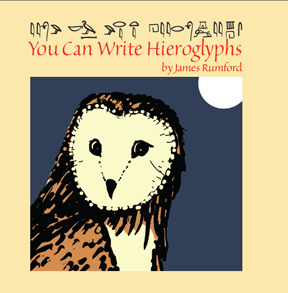How do you discover
something new?

To purchase a copy of Seeker of Knowledge, click here.
When I was a boy, I was fascinated with things Egyptian. I especially liked the paintings they did on the walls of their temples and tombs, and I thought that their hieroglyphs were beautiful beyond words.
Sometime in high school, I read a biography of Jean-François Champollion’s life. The author wrote about Champollion with such energy and poetry that the words stayed with me long after I had forgotten both the title and the author of the book I had read.
It was with the bits and pieces of this memory that I constructed my picture biography . . . that and a lifelong interest in ancient scripts and their decipherment.
What Champollion did in the 1820s is what I would have liked to do, but I do not have the analytical mind it would take to decipher a lost language systematically. Even so, I put in my book the drive that a decipherer must have—that feeling of never giving up—and, when success is achieved, the exhilaration of victory.
How I Structured the Book:
Writing a biography for children seems like a fairly straightforward task. You relate the events of the person’s life in chronological order. What you end up with though is a piece of writing that might appear in a wikipedia-like article online. To me this seems not worth the trouble. Instead, I think that it is best to give the reader a definite point of view.
An effective way of doing this is to think of a metaphor that stands for the person’s life. For Jean-François Champollion I chose the ibis bird. In Ancient Egyptian, the hieroglyph for the ibis was used in words that meant ‘to seek.’ This seemed to symbolize Champollion’s life: he was a seeker of knowledge. More than that the ibis bird was the symbol of the Egyptian god of writing Thoth. Throughout the book, I returned to this metaphor again and again not just in words but also in pictures.
Defining a person’s life with a metaphor makes the writing task easy. Take any famous person’s life and you are bound to find some metaphor worth using. Martin Luther King, for example, talked of different races sitting down at a table to eat together. Perhaps, in researching Dr. King’s life, we might see instances of the importance of family gatherings at meal times. Perhaps these events could be woven into a story of the man’s life, culminating in his famous ‘I have a Dream’ speech.
Another example is my book Sequoyah. In it I compared the Cherokee man who invented writing for his people with the Sequoia tree. The result was a comparison that made it clear to young readers what type of man Sequoyah was.
Two other examples are the fine biographies done by Peter Sís and Alice and Martin Provensen. If you get a chance, read Starry Messenger and The Glorious Flight. The simplicity and power of these two works will take your breath away.

